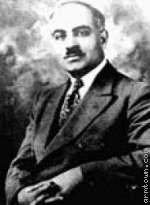Where memory becomes legend
Reviewed by Alev Adil
Friday, 18 January 2008
It is 1915, and Sempad the prosperous pharmacist and his family are excitedly making preparations for his brother Yerwant's visit after decades abroad. The Pharmacie Hayastane, named after the lost homeland of the Armenians, is a "beacon of prog-ress and civilisation" in their little Anatolian town. The Arslanian family are busy putting the finishing touches to Skylark Farm, their new country house, with tennis and croquet lawns and rose-covered pergolas, while in Italy Yerwant dreams of building a villa nearby where he can retire.
This is a bucolic paradise, yet from the first we know that disaster looms; most of the family will perish. The reader has already met little Henriette, three in 1915, as an old lady accompanying the author to her first name-day church service in Italy. Arslan's first novel is also a family memoir, and bears witness to the Armenian massacre that wiped out so many of her forebears in Turkey.
Her imagined history is frequently mystical. Some have had premonitions, "smelled blood in the air, caught the scent of evil" or had visions of the archangel surrounded by evil fire. The paterfamilias, Hamparzum, sees the horsemen of the Apocalypse as his toddler grandson feeds him grapes on his deathbed. He entrusts the child to the Virgin as he dies.
The atrocities they suffer are hard to read, both because of the horrific events and Arslan's purple prose. Leslie is "flung against the wall, where his small round head smashes like a ripe coconut, spraying blood and brain across the delicate floral designs." Carnage becomes religious kitsch, as when Hripsime sees her baby skewered on a bayonet, "the joyous soul of her little Vartan hesitantly trying out his new wings".
Leaving aside literary quality, Arslan's novel raises compelling questions about the traumatic historical events that shaped our inherited identity – here, where memory becomes third-generation legend. The Armenian massacres are said to have served as a model for Hitler's subjugation of Poland. Here the collective memory of the Holocaust serves as the model for imagining the Armenian genocide. Arslan inappropriately attributes Nazi ideologies to the Ottomans. Setrak the baker becomes a sub-human collaborator with the Kurdish guards. Arslan calls him "a capo": I read this to mean kapo, a term borrowed from Nazi concentration camps. This was the only moment Geoffrey Brock's translation offered anything less than lucid clarity.
The narrative has echoes of Schindler's Ark. Ismene, a wily Greek and Nazim, a Turkish beggar, save the survivors. Nazim is no Schindler, though, compelled by greed as much as remorse. There's little hope for redemption or reconciliation here, in the face of an inherited, implacable grief.
Atlantic £12.99 (275pp) £11.69 (free p&p) from 0870 079 8897
http://www.independent.co.uk/arts-entertainment/books/reviews/skylark-farm-by-antonia-arslan-trans-geoffrey-brock-770990.html
Wednesday, June 25, 2008
Subscribe to:
Post Comments (Atom)

No comments:
Post a Comment